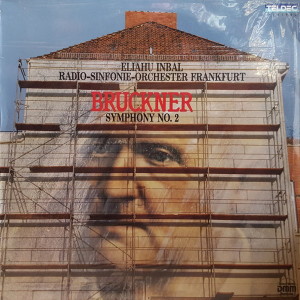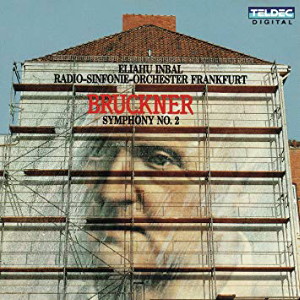 |
|
1 LP -
6.44144 AZ - (p) 1988
|
 |
| 1 CD -
8.44144 ZK - (p) 1988 |
|
| ANTON BRUCKNER
(1824-1896) |
|
|
|
|
|
| Symphonie
Nr. 2 c-moll - Revidierte
Fassung von 1877 |
61' 34" |
|
| -
Ziemlich schnell |
20' 01" |
|
| -
Feierlich, etwas bewegt |
16' 11" |
|
| -
Scherzo: Schnell - Trio: Gleiches
Tempo |
7' 13" |
|
-
Finale: Mehr schnell
|
17'
51" |
|
|
|
|
| Radio-Sinfonie-Orchester
Frankfurt |
|
| Elihau Inbal,
Leitung |
|
|
|
|
|
Luogo
e data di registrazione |
|
Alte
Oper, Frankfurt (Germania) -
giugno 1988
|
|
|
Registrazione:
live / studio |
|
studio |
|
|
Producer /
Engineer |
|
Wolfgang
Mohr - Hans Bernhard Bätzing /
Martin Fouqué
|
|
|
Prima Edizione LP |
|
Teldec
- 6.44144 AZ - (1 LP) - durata 61'
34" - (p) 1988 - Digitale |
|
|
Prima Edizione CD |
|
Teldec
- 8.44144 ZK - (1 CD) - durata 61'
34" - (p) 1988 - DDD |
|
|
Note |
|
Co-Produktion
mit dem HR, Franfurt.
|
|
|
|
|
“I
only write music, and not
reviews, so that the Lord
has no cause to say to me:
‘Why haven’t you produced
anything my fellow? I gave
you talent to edify and refine
mankind, to fill men with
lofty thoughts, and you
have produced nothing!"
Anton Bruckner 8th May
1893, during the interval
at a university lecture.
Bruckner was actually
anything but unproductive:
he worked tirelessly,
despite moments of deep
resignation, despite all the
disappointment that resulted
from the poor reception of
his music. But his
application was of little
use to him in this life:
Anton Bruckner was a
tragically unrecognised
genius, and the fate
initially suffered by the
fruits of his life’s work
reflects an age
unfortunately rich in
musical philistines.
How much would have been
lost to the world, had it
not been for Bruckner’s
unshakeable will to compose!
As it was, he lived in the
consciousness of a mission
on which the final judgment
would not be passed by the
critic Hanslick or by his
fellow composer Brahms.
“Bruckner? An utter fraud!
He’ll be forgotten within a
few years of my death.” -
thus Brahms to the Austrian
critic Richard Specht in the
spring of 1897. Bruckner
himself, who died a year
before the Hamburg
composer's ungenerous fit of
anger, had already remarked
polemically some years
earlier (8th January 1892):
“They called Beethoven the
musical pig in his time, and
said he should be locked up
in an asylum. I think to
myself: You just carry on
writing, just look straight
ahead. I’ll
long since be in my grave by
the time Hanslick
understands..."
Anton Bruckner stood alone,
as his favourite pupil Franz
Schalk commented, “without
support from anyone, truly
helpless, yet unshakeable in
the humble belief in Eternal
God, in the proud, almost
heathen belief in himself
and the glory of his music.”
Bruckner was in no way an
urbane man, he was the
simple product of a
money-oriented, secular,
bourgeois era - yet in some
mysterious fashion, he
created musical - urbane! -
culture of lasting, global
status from a unique
symbiosis of naive rural
piety and gigantic inner
musical visions. It was
Bruckner, and not Brahms,
who carried on the Austro-German
symphonic tradition after
the death of Robert Schumann
in 1856: both Brahms and
Bruckner came to symphonic
composition late in life,
and Bruckner wrote his First
Symphony when he was almost
42 (1865/66) - some ten
years before Brahms
completed his ’First’ (the
'Tenth' according to Hans
von Bülow!) in
1876 at the age of 43.
The Second Symphonie in C
minor was composed at a time
when Bruckner had found
international recognition -
albeit as an organ
improviser rather than a
composer - which gave him
enormous inner momentum: in
1869 he played in Paris
(Notre Dame), and in 1871 he
had taken part in a
competition in London on the
new organ in the Royal
Albert Hall that had been
built for the World
Exhibition. After his return
to Vienna, Bruckner began
work on his Second Symphony.
He composed the first
version of the work between
11th October 1871 and 11th
September 1872, and gave the
symphony its first
performance in this form on
26th October 1873 in Vienna.
He dedicated this first
version to the Philharmonic
Society. On the advice of Johann
Herbeck, Bruckner reworked
the symphony, and this
revised version was first
performed on 20th February
1876. Finally, in the
following year, a third and
last version appeared: the
composer dedicated it to
Franz Liszt, whom he had met
at the singers’ festival in
Pest in 1865.
It is interesting to observe
how Bruckner relies on the
principle of the 'talking
pause’ in his Second
Symphony, the considerable
structural power of the
General Pause. (Thence the
nickname ’Pause Symphony’.)
The contrapuntal and the
dispositive precision work
are intensified in relation
to the First Symphony; the
principle of the composer
quoting himself is found in
the Adagio, that refers to
the Benedictus, and in the
finale, which refers to the
Kyrie of the F minor Mass.
Furthermore, two other
features of Bruckner’s music
make their first appearance
here: firstly, the
embellishment of one step of
the scale by the upper and
lower leading notes, and
secondly - taken over from
Wagner - , mixed rhythm
within one bar.
Bruckner’s Symphony no. 2
has four movements. The
first in the principal key
of C minor is in sonata
form, with three thematic
groups in the exposition,
epilogue and epilogue-coda,
a development section,
reprise and coda. The second
movement in A flat major is
a sonata form without the
development section. The
third, one of Bruckner’s
most extraordinary scherzi,
is in the key of C minor
with a C major trio, while
the finale, which is
governed by C major and
minor, is once again a
richly varied sonata
structure with an exposition
containing three thematic
groups, epilogue and
epilogue-coda, plus
development, reprise and
coda to the movement as a
whole.
The 'original version’ was
not published until 1938,
when it was brought out by
Robert Haas. It is based in
fact on the third version
dating from 1877 - this,
however, also uses elements
from the first version of
1871/72, thus eliminating
the 139-bar cut which would
have altered the proportions
of the entire work. In
addition, the
instrumentation, dynamics
and phrasing were adopted
from the first version. This
seems sensible, for, as
Bruckner rightly commented
in answer to suggestions for
shortening his F minor Mass
(1893): “I’ve
already kept it short. If I’d
written down everything I
thought of to the greater
glory of God, it would have
been even longer.”
Knut Franke
Translation:
Clive R. Williams
|
|
|